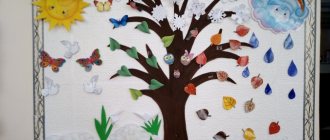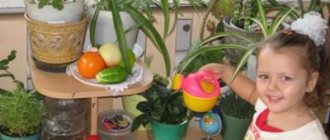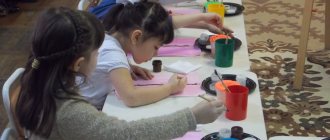Children's subject-development environment
Organization of zoning of a kindergarten group
A subject-development environment is a space through which the process of development of children's interests, forms of activity, and development of imagination takes place. With the help of a subject-based developmental environment, children learn to express themselves and develop creative abilities. In our group, the subject-development environment is enriched with various materials; all components are interconnected in content, artistic design, and contribute to meaningful communication between children not only among themselves, but also with adults. Also, our subject-development environment is functional, very easily transformed, easily accessible and safe, and provides maximum playful, creative, cognitive, motor, and research activity for pupils. Children experiment with available material, develop fine motor skills, and participate in active and sedentary games and competitions. Before dividing the group into zones, we sketched out a plan that would take into account, first of all, the interests of the children.
Sports section
. It's no secret that children are very active, so it was decided to start our zoning with the sports corner. It contains everything you need for physical development: skittles, jump ropes, cubes, and so on. Morning exercises and outdoor games take place here every day. In addition, physical education classes are held in the sports corner area. This area is of great importance for children; they happily spend their free time there. In the corner you can also find sports equipment for various relay races. And the games “bowling” and “towns” are among the most favorite.
Traffic rules corner
. The modern world has long been unimaginable without cars, so children must be taught the rules of the road from childhood. This corner contains the basic rules of behavior on the road. Here we talk in a playful way about the rules of behavior on the roadway and pedestrian area, simulate life situations, and predict our actions in various road incidents. Over the course of a month, posters describing the rules, traffic signs, cars, a model of the roadway, and a book of traffic rules were collected. With the help of all this, we help children develop knowledge about the rules of behavior on the street, on city roads, and in public transport. We also selected board games on the topic of road rules for this corner. If we need to keep our children busy with something useful, we turn to the corner with traffic rules.
Ecological corner
. When humanity begins to cut down forests and litter the seas, oceans, and rivers, you begin to think about how to teach the new generation to understand that we must protect nature. Therefore, the creation of an ecological corner was included in our project plan when planning zoning. It is located next to the window and helps to expand knowledge about the world of plants, foster a caring attitude towards nature, and introduce children to caring for plants. Here we observe indoor plants, study their diversity, learn to care for them using special equipment: a watering can, a sprayer, and shovels to loosen the soil. Every morning begins with the children caring for the plants.
Thematic corners
. Games are the transformation of children into adulthood. Children play as if they live with adults. Within the walls of the kindergarten, we decided to create the main places for children to visit outside the walls of the kindergarten. These include a clinic, hairdresser, shop, beauty salon, cafe, post office, fire station. It's interesting to watch children grow into little adults with serious dialogue.
Corner of role-playing games
. All materials are selected taking into account age and individual characteristics, for girls and boys. Different board games allow children to play together according to certain rules. The games change every week.
Mummers Corner
. Children love to go to the theater and watch all kinds of productions in different genres, and then play it out with their peers. Our corner allows children to feel like real actors. To better perform the role, children need outfits, and the small costume room we created helps them with this.
Book corner
. Considering the technology of the time, when many gadgets are replacing books from people’s lives, we believe that it is necessary to create a corner with books and magazines in the group in order to accustom children to read and look at books independently. Our corner with books is presented in the form of a table with books, illustrations for fairy tales. The material changes according to the material covered. As children's educational magazines come out, our corner is replenished with them. Children enjoy solving crossword puzzles, solving riddles and reading poetry by modern authors.
Creativity corner
. All children love to be creative. Of course, we need to find a place for such a corner. Our corner is equipped with materials for various creativity: colored pencils, coloring books, paper, stencils. Here children satisfy their needs for self-expression, regardless of adult guidance. A child can transfer his emotions and experiences onto paper, create his own album with drawings, or glue together an unusual toy. Or repeat the teacher’s task that the child liked during the lesson.
Relaxation corner
. All people need rest, and children especially. To create favorable conditions in the relaxation corner, we placed a comfortable soft sofa, where children can retire if they are tired or in a bad mood. Some just want to relax, others gather in groups and play games of their own design. Also in the center of the group there is a carpet on which children play active and sedentary games, as well as games of their own design with various playing materials. Everything is in a place accessible to children. We suggest how to correctly use certain attributes. We care about the full and diversified development of children in our group, we add some material, remove some, this mobility of materials allows children to fully, and most importantly, productively use their free time. We involve parents in equipping our corners. The result of our work is healthy and joyful children.
Tatyana Buzanova, Irina Martyunina
teachers, kindergarten No. 26 “Forget-me-not”,Dolgoprudny, Moscow region.
Principles for designing a playroom in a preschool educational institution
1. Zoning
. It is necessary to divide the playroom into zones with different types of toys. This will avoid mixing gaming and educational processes.
2. Safety
. There should be no dangerous places in the room. You should stick soft corners on sharp corners, use plugs for heavy doors (stoppers), install limiters on windows for ventilation, purchase curtains for sockets, hide all wiring, and also pay attention to the floor - it should be smooth and warm.
3. Comfort
. Arranging a playroom begins with preparatory work. It is important to provide a suitable microclimate: temperature, humidity, lighting, fresh air flow. To monitor environmental indicators, it is better to install a weather station.
4. Saturation and variability
. The equipment of the game room should be varied and colorful. This will not only give children a choice, but will also decorate the room. It is desirable that the equipment provides all types of activity: motor (including fine and gross motor skills), cognitive, research, creative, joint. Also, do not forget to periodically update the game material.
5. Availability
. The playroom equipment should be located within the child’s reach so that he can use it independently at any time. Toys must be in good working order, appropriate for the age, and, if necessary, the limitations of the children.
6. Transformability and multifunctionality
. You will be able to use your budget rationally with equipment that is interesting to children of different ages and has various options for use. For example, soft modules are suitable for relay and building games, as well as for recreation. At the same time, both babies and older children (preschoolers) love them.
Interior design and architecture
All materials in the playroom, including construction materials, must have certificates confirming their origin, quality and health safety. Also, materials must be resistant to wet cleaning and disinfection. In accordance with these requirements, the following options are possible for the design elements and architecture of the game room:
1) floor, walls, ceiling
. According to the standards, the area of the playroom for early age groups (children under 3 years old) is determined at the rate of at least 2.5 × 2.0 m per child, for preschool age (children 3–7 years old) - at least 2 .0 × 2.0 m. The following floor coverings are allowed: linoleum, parquet, cork flooring, carpet. You can put, for example, a puzzle mat on top. To paint the walls, choose matte light colors: sand, turquoise, cream, coffee, light pink, lilac, etc. The walls can be decorated with children's images, vinyl stickers, paper applications, posters, etc. The ceiling can be either a regular whitewashed or painted, tiled and fabric stretched;
2) windows, lighting, furniture
. Curtains or blinds in light colors are required on the windows. Lighting (warm, perhaps with a yellowish tone) should be general and uniform, without open spotlights or harsh light. The sizes of drawers, cabinets, shelving and other furniture are selected according to the age of the children. In this case, the color of the furniture is allowed to be bright.
What do you need to know about SanPiN in preschool institutions?
Sanitary and hygienic rules and regulations for preschool institutions are approved by SanPiN 2.4.1.3049-13.
The act, approved by the Decree of the Chief Sanitary Doctor of the Russian Federation dated May 15, 2013 No. 26, includes rules governing the organization of the organization and the rules for the use of accessories for children accepted into groups.
The act establishes requirements for:
- location of the preschool educational institution;
- equipment, including its location;
- maintenance of territories related to a children's educational institution;
- maintenance, decoration of premises, the building itself;
- lighting of rooms, as well as auxiliary premises (natural and artificial);
- heating, water supply, ventilation, sewerage and other systems;
- the formation of groups that accept children with diseases that limit their health;
- admission of minors to organizations implementing preschool education programs;
- organization of the regime and educational process, including training;
- equipment, inventory, toys, dishes and equipment in the catering department;
- conditions of preparation, storage of food, menu preparation;
- transportation, food intake;
- hygienic, anti-epidemic measures;
- compliance with sanitary standards.
All of the above requirements must be strictly observed by employees of preschool institutions.
For refusal to comply with the rules, citizens and organizations face a hefty fine. Next we will talk about labeling furniture and utensils in preschool educational institutions.




